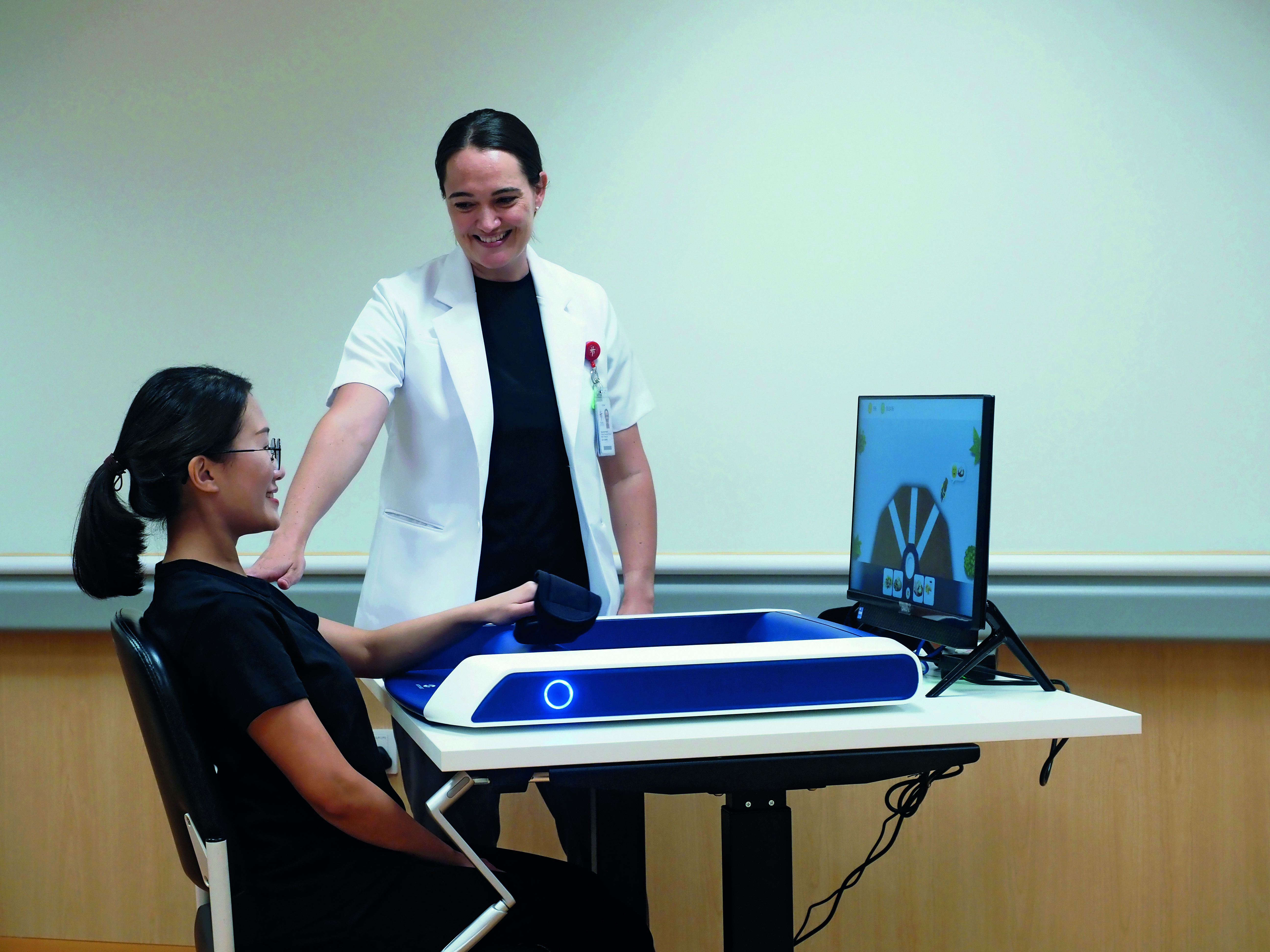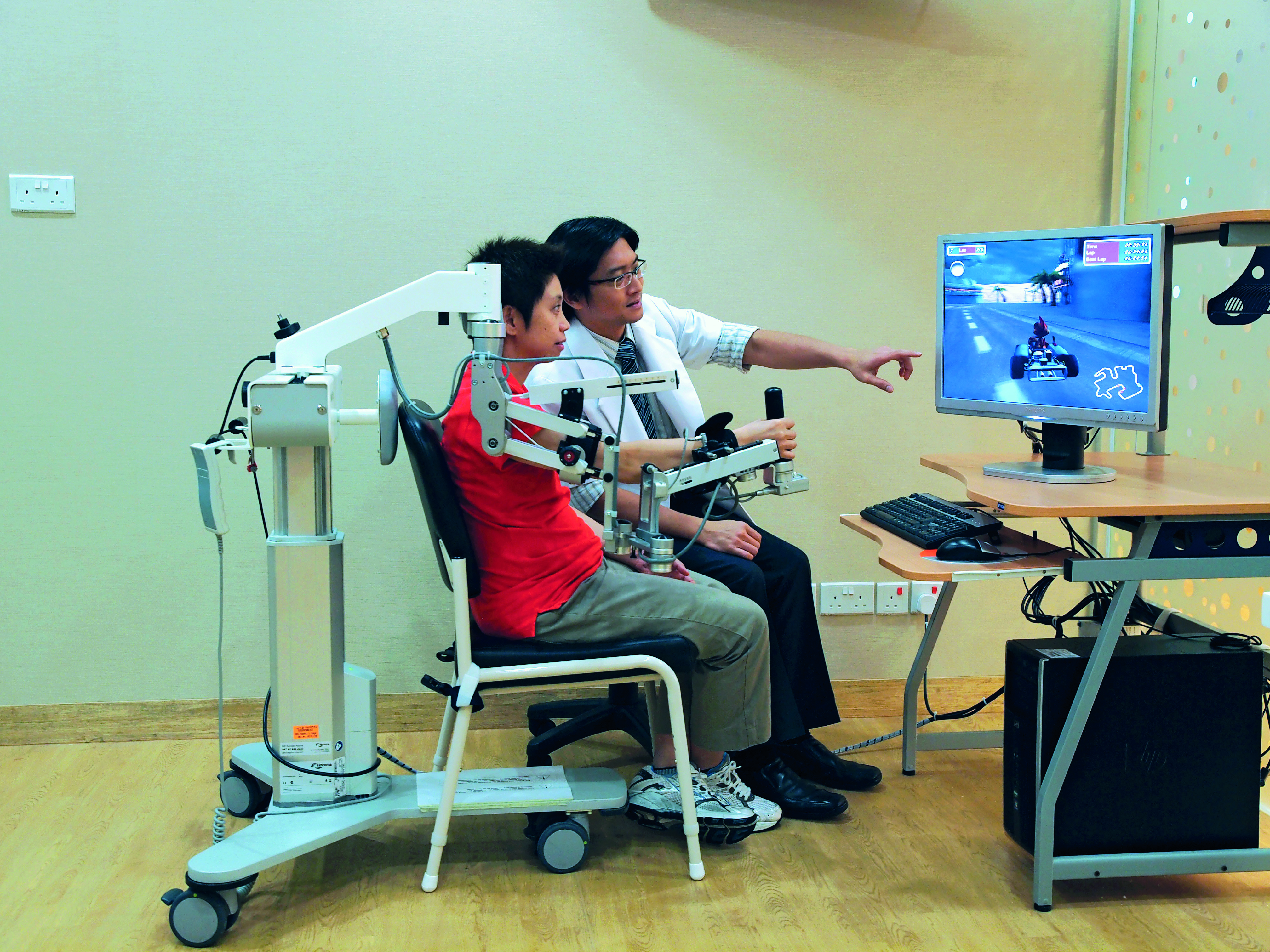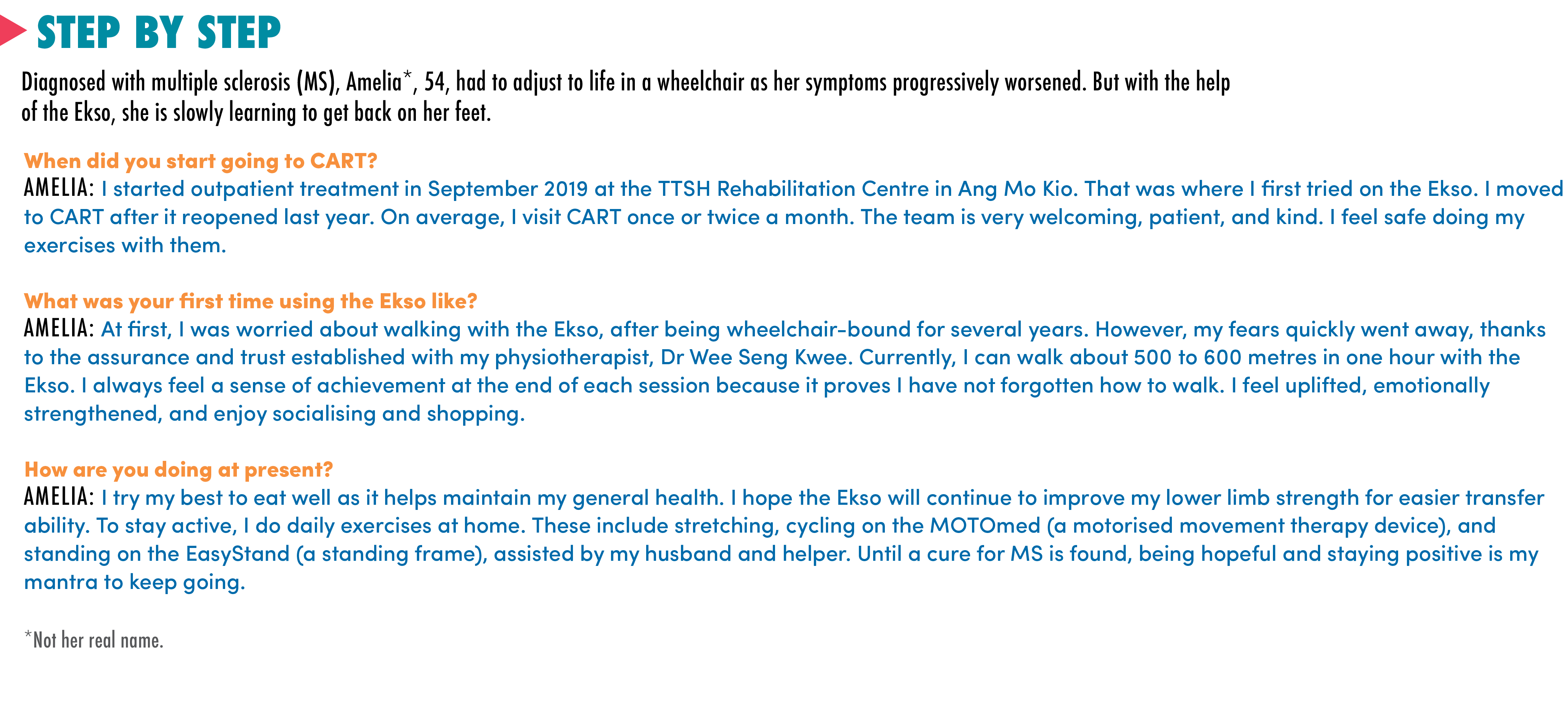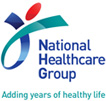Within the National Healthcare Group (NHG), TTSH’s A/Prof Loh and his colleagues work together with community hospitals, day rehabilitation centres, and home-based rehabilitation care providers to care for patients in the Central and North regions of Singapore. For example, TTSH has a close partnership with Ang Mo Kio – Thye Hua Kwan Hospital (AMK-THKH), a community hospital that provides mainly rehabilitative and geriatric care. It is where the TTSH Rehabilitation Centre is currently located until it moves to ICH in HealthCity Novena in September this year. Strong care coordination is key to ensuring that patients’ transition between care settings is well-supported.
For instance, A/Prof Loh’s team has formed a tripartite collaboration with the National Neuroscience Institute (NNI) — which has a campus at TTSH — and AMK-THKH. “The collaboration facilitates fast-track, seamless transfers of stabilised stroke patients from NNI@TTSH to AMK-THKH, where we work with clinicians to co-manage them,” he says. “We also train AMK-THKH staff to use the robotic rehabilitation technologies at its premises.”
The rehabilitation technologies offered at AMK-THKH can also be found at TTSH’s outpatient clinic for Advanced Rehabilitation Therapeutics (CART). High-tech equipment is a key feature of the clinic, and may account for why many patients report positive experiences and succeed in achieving their rehabilitation goals.
Opened in 2011, CART was the first centre in Singapore to combine robotics and virtual reality (VR) with conventional rehabilitation therapy. It was also acclaimed for its multidisciplinary team-based approach, with rehabilitation physicians working alongside nurses, therapists, prosthetists and orthotists, psychologists, medical social workers, and dietitians to provide holistic care. These features are still in place, and even more evident, at the new and improved CART, which reopened in April 2022.
"We hope to expand CART's clinical services and cater to more outpatient tertiary rehabilitation needs."
- Associate Professor Loh Yong Joo
Spanning 19,935 square feet, the revamped facility is four times larger than before and houses state-of-the-art rehabilitative robots and a bigger gym. “The conditions we most commonly treat at CART are stroke, traumatic brain injury, spinal cord injury, and amputation. With the increased space, we have recently started managing patients with cancer, demyelinating diseases such as multiple sclerosis, and those who are ventilator-dependent too. We hope to expand our clinical services and cater to more outpatient tertiary rehabilitation needs,” says A/Prof Loh. While patients range in age from 12 to 85 years old, he notes, “Most of our patients here are in the older age bracket, with an average age of 64 years old.”
CART’s suite of tech-aided rehabilitation programmes includes those targeting the upper and lower limbs. For example, patients with lower limb impairment can relearn to walk using the Lokomat or the Ekso. The Lokomat is a robot-assisted gait training system that straps patients into a harness while they practise walking on a treadmill. The Ekso is a wearable exoskeleton inbuilt with programmable sensors and motors to help users relearn the correct stepping pattern, weight shifting, and balance. Both devices give instant feedback, reduce the burden on therapists, and empower patients to walk for longer distances than they would via conventional physiotherapy, thus improving their mobility potential.
To tackle upper limb weakness, rehabilitation programmes employ technologies like the Amadeo (which trains the hands and fingers) and the Armeo Spring (a single-arm exoskeleton that simultaneously trains arm movements and grasp functions). A made-in-Singapore solution is the H-Man — a portable, artificial intelligence (AI)-enabled arm rehabilitation robot co-developed by the Nanyang Technological University (NTU) and CART. All three devices are connected to a computer screen and present training exercises in the form of interactive video games, for a fun and engaging experience. “Fun gamification elements motivate patients to increase the frequency and intensity of repetitive, task-specific training,” says A/Prof Loh.

 The H-Man is a portable, AI-enabled arm rehabilitation robot (Left). The Armeo Spring is a single-arm exoskeleton that simultaneously trains arm movements and grasp functions (Right).
The H-Man is a portable, AI-enabled arm rehabilitation robot (Left). The Armeo Spring is a single-arm exoskeleton that simultaneously trains arm movements and grasp functions (Right).
FROM IDEA TO REALITY
As in the case of the H-Man, CART does more than provide sophisticated rehabilitation technologies for the benefit of patients — it also helps make some of these inventions a reality. Through collaborations with academic and industry partners, the clinic co-develops and test-beds novel technologies, which are then scaled up and rolled out to the market.
Following successful H-Man trials at CART, a medtech start-up called Articares was spun off from NTU to commercialise the product. H-Man is now used in different rehabilitation settings around Singapore — including acute and community hospitals, senior care centres, and nursing homes — and has attracted overseas interest. Moreover, the device’s portable and user-friendly design makes it conducive to home use. This may speed up patients’ recovery, by allowing them to continue therapy in the comfort of their own homes.

“We are in the process of rolling out the H-Man as a home-ready service, possibly on a subscription model,” says A/Prof Loh, adding that a pilot study is ongoing to explore its suitability for telerobotics rehabilitation. “Currently, we offer video consultation via Zoom, where we advise patients remotely on recommended exercises they can do at home. What we hope to do is move beyond tele-rehabilitation to telerobotics rehabilitation — patients set up the device at home and we supervise them in real time when they use it.”
Mobile applications offer another avenue for patients to exercise anywhere and at any time. During the pandemic, TTSH partnered local company Taggle to develop two applications:
Heart-Track for cardiac rehabilitation (to help patients who have undergone heart surgery), and
MoveVID for pulmonary rehabilitation (to help patients with respiratory symptoms, such as those with long COVID). Both applications provide a customised, gamified exercise programme for users, and are paired with wearable sensors. That way, patients can perform the exercises on their own while having their vital signs continuously monitored, for safety and effectiveness.
Staying with ‘exergaming’ applications, a new digital set-top box with VR simulations — called the HealthKiosk — has been installed at CART. Co-created with Taggle, it contains fun and motivational video game-based exercises that cater to the needs of elderly individuals, such as fall prevention or recovery from stroke. Other similar devices currently undergoing clinical trials at CART include DancingMind’s immersive VR headset (which offers a library of therapeutic games) and the EvolvRehab platform (which combines VR, motion capture, and gaming technologies).
CART has embarked on a multi-year partnership with Fourier Intelligence, a global rehabilitation
robotics leader, to validate and implement rehabilitation technologies more widely across the community. Similarly, interdisciplinary research at the Rehabilitation Research Institute of Singapore (RRIS) aims to provide Asian-centric solutions that harness the latest robotic, AI, and machine learning technologies. The RRIS was jointly founded by NHG, NTU, and the Agency for Science, Technology and Research (A*STAR) in 2016.
A/Prof Loh shares, “Through RRIS, we have developed a wearable exosuit that can potentially improve upper limb function in stroke survivors. The project is still in the prototype stage, and it holds much promise.”
THE NEXT 50 YEARS
Soon, NHG will welcome the TTSH Rehabilitation Centre back at the new TTSH ICH. This 22-storey building will serve as HealthCity Novena’s rehabilitative pillar, with 500 beds dedicated to rehabilitation and sub-acute care, and another 100 beds for palliative care. Other purpose-built spaces include a multi-sports arena and rehabilitation gardens. Looking ahead, CART is expected to move to TTSH’s future ambulatory block in the mid-2030s, hopefully to an even bigger clinic than the present one. Co-locating and upgrading these facilities within HealthCity Novena will enable closer coordination of care and patient transfers, and ultimately facilitate patients’ transition back to the community.
“In the coming years, our services will continue to focus on major conditions such as stroke, musculoskeletal, and geriatric rehabilitation. Cancer rehabilitation will be another major area, due to better screening diagnostics and therapeutics,” A/Prof Loh predicts. He believes this will open a wealth of possibilities in advanced robotics, VR, serious gaming, tele-robotics rehabilitation, mobile applications, wearables, brain-computer interfaces (where a person can control a device using brain signals), as well as AI and machine learning software. Such tools will enable data-driven precision rehabilitation, characterised by personalised care and accurate tracking of patients’ movements wherever they are.
“We have an ‘Every Moment Is a Rehabilitation Moment’ mindset,” says A/Prof Loh on the notion of patient empowerment. “It entails supporting patients post-discharge by connecting them to a community of rehabilitation providers, motivating patients and their caregivers to take ownership of their rehabilitation, and using technology enablers to support their recovery in the community and at home.” LW
Read the e-Book of the magazine
here
